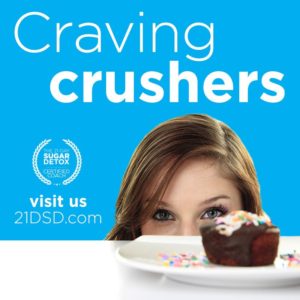Hey Folks! We're excited to welcome back Certified 21DSD Coach Michal Ofer. Michal's article is part of a series contributed by our Certified 21DSD Coaches. Enjoy! – Diane and Team
Cravings: a cringe worthy word!
Cravings are by far the number one saboteur of any eating plan, diet, challenge or nutritional program. They are insidious, nasty little critters that seem to appear out of nowhere and aggressively destroy the best of nutritional intentions.
Here you are, consciously adhering to your 21-Day Sugar Detox plan when out of the blue you find yourself eating some strange concoction from the corner store. It hardly even tastes decent.
Cravings are contagious. At work, a colleague, driven by her cravings, leaves the office, only to return with her latest affliction (a pumpkin spice latte and a white chocolate macadamia cookie), for you to see and smell, playing with your resolve and toying with your emotions. All of sudden all forms of self-discipline and words of conviction have disappeared out the window.
Do you feel your cravings are sabotaging your efforts to implement and maintain your healthier lifestyle? Do you want to fix that?
First, let's deconstruct cravings from a physiological standpoint.
Cravings come from four root sources: bacterial, nutritional, emotional, and physical.
- Bacterial imbalance in the digestive system can cause raging sugar cravings to feed the yeasts and fungi that need these carbohydrates to survive.
- Mineral and vitamin deficiencies lead the body to crave foods that provide a burst of energy, or a reliable dose of some missing or depleted nutrients.
- Emotional cravings for joy, connection, and relaxation often result in yearnings for sugar and fat to help calm the physical manifestations of fear, anger, and anxiety.
- As humans, we instinctively seek physical pleasure. Our modern sedentary, physically disconnected lifestyle keeps us from physical touch and connection, or finding joy in moving our bodies. We have forgotten that our bodies are designed to thrive with consistent, enlivening movement. The connection with our bodies has disappeared and we have been taught shame around desires and cravings. The overlap between the sensual pleasures from food and companionship creates confusion and food is often a replacement for intimacy.
Here are a few tools my clients and I have successfully used to constructively deal with the emergence of cravings, on all levels.
 Stop fighting
Stop fighting
Before you close this and stop reading, wondering what this craziness is, humour the explanation: One of the biggest mistakes people make when they change their eating habits, clean up their diets or embark on a 21DSD is that they eat way too little. This means too little food overall, or insufficient fats and nutritious carbohydrates (both vilified by the media) for their individual needs. Too little fat in the diet is directly correlated with increased sugar cravings and eating too little food in general is not sustainable over the long term. Eventually the body will begin to break down. The body is left depleted and desperate and the mind begins to focus on everything it believes it is being deprived of.
Eat real food, and enough of it, including some nutrient dense carbohydrates (as permitted on your level and for your modifications of the 21DSD) and naturally occurring saturated fats. This will build up defenses against the attacking craving gremlins, providing the fuel to prevent their appearance, or at least stave off their attacks. Logically, the preference is for a sustainable nutrition program where feeling good is easy and effortless over the long term, rather than continuously crash dieting to lose weight, only to wreak havoc with metabolism, gain back more than what was initially lost, feel downright awful and grumpy, and continue engagement in this downward spiral.
Keeping better food choices and options around will help get you through the tougher moments. Grains and sugars are highly addictive. The more you eat, the more you want. Self-control or that ever evasive willpower helps very little in the presence of strong neurologically driven “needs.” Removing these from your immediate surroundings wherever possible is often a good tactic.
Eating a reasonable amount of a food is made easier when said food is not acting like a drug in your body. Eat the good stuff and keep your food as close to its natural state as possible. This way, you are not interfering too much with the addictive center in your brain.
Your 21DSD-friendly fruit is not the enemy
Fruit seems like a poor substitute when you are craving chocolate. I used to feel that way until I broke up with commercial chocolate. We had a slightly co-dependent relationship, meaning I was dependent on it. A little digression, so onward…
When removing processed foods from your diet you may experience severe cravings for something sweet. Worrying about the consequences of a “healthier” treat option (a 21DSD-approved, real food based baked treat), or your green apple (or green-tipped banana if you are so inclined) can occasionally result in throwing caution to the wind and going a little crazy on the leftover Halloween candy or box of cookies.
The problem here is not just setting yourself back in that moment by eating something which negatively impacts blood sugar levels and possibly results in a less than optimal physiological response; it is also beginning the cycle of grain and sugar lust all over again. This can often last for several days. The best solution for something sweet is a real food based treat or, ideally, a piece of your 21DSD fruit. Concentrate on foods free from the grains, excessive sugar, and other ingredients certain to set off those addictive brain chemicals.
Use distractions
So often your cravings are just mental. They actively live in your head, a product of your old habits. At 10 am you should be having a snack to “keep your blood sugar stable.” At 3 pm the expectation is to have a “pick-me-up” treat. At lunch, dessert has always been some sugar-filled substance, and so on and so on. The mind, being a creature of habit, will, at specified times start wondering “Where’s my (insert treat of choice here)?” In reality, the need is not there, just the want.
If the above tips are of no help, try the following:
- Take 5 deep, slow breaths. Take that time to choose what you really want to do next.
- Drink a glass of water. So often, a craving is just thirst in disguise.
- Move your body, go for a walk, do a 3-minute vigorous session of squats in your office or living room. The key is to get yourself out of your current situation and brain space and change locations for a while.
- Talk to someone, call someone, reach out to someone. It could be someone you trust and someone who knows your health goals and who can help remind you why you would not want to cave to your cravings, or it could be someone who provides a quick and easy distraction, again, getting you out of your brain space..
Cravings are a painful, frustrating thing. It is really tough to work through them when they decide to rear their ugly heads. Trying some of the above methods and tips will allow you to determine if and how any of them work for you.
The emphasis here is on having a few healthy, real food based, non-toxic, gluten free, grain free, 21DSD-approved treats available to you if you know that cravings appear for you regularly. This is especially important in the beginning week of your 21-Day Sugar Detox. Needing a crutch, a replacement or an alternative is totally acceptable. The baked goods, treats and snacks can be consumed, as long as they are made with plan friendly ingredients, eaten mindfully and treated as what they are: treats, not meal replacements.
Making larger batches and keeping them individually wrapped in your fridge or freezer makes them easily accessible. Keep some at work so alternatives exist in all areas of life. Feeling deprived of previous food staples is unnecessary and getting used to new behaviours does take a little time. Keep at it and notice the benefits of eating real food start to shift your behaviour, and your life.

Michal Ofer is a certified life coach, health coach and 21DSD coach.
She has always had a love for food, cooking and all things nutrition related. Michal grew up in South Africa where she studied biological sciences and got her degree in Optometry with a minor in holistic nutrition. After some travelling, disguised as learning overseas, Michal immigrated to Canada where she worked in business development and team building. A less than positive experience with the current acute care medical system and “Standard American (Canadian) Diet” whilst trying to overcome a chronic health issue led Michal on a path to discovering that food truly is our best medicine and that all healing begins in the gut. Once recovered, Michal wanted to help others reach their optimal level of health, wellness and vitality that a real food approach to diet gives. Michal is a nutritional consultant working with individuals looking to improve their general well-being, with a special emphasis on naturally and holistically healing the damage that disordered eating creates in the entire digestive system. When not counselling others or trying to keep up to date with the online world, Michal is an amateur cook, testing her newest food creations on brave volunteers. She can be reached at [email protected] for further insight into moving beyond eating disorders.


Comments 2
Hi! I have attempted the 21 Day Sugar Detox on 3 separate occasions. After the initial first several days of the “carb flu”, I’d start losing weight, lose my sugar cravings, and generally feel great….more energetic, sleeping like a baby, bloat-free. etc. However, on each of the three occasions that I did the detox, at around day 14-16, I’d develop some severe headaches. Almost on the verge of having migraines. The headaches were so bad I didn’t feel like I could continue, ate some type of “fast-acting” carb and , immediately, the feeling of calmness and relief washed over me. I have to admit that sugar has been a big part of my life. I have a huge sweet tooth and I believe I could be the poster child for sugar addiction. And my health shows that. I have various medical concerns and chronic medical conditions that require regular monitoring. I have been trying to change my habits in ways that I can live my life in the most healthful way possible. Sugar has to be the number one road block to that end. My question is: why, after initially feeling so good, do I hit a wall at the 2 week mark and develop these severe headaches? What can I do to make it through the full 21 days so that I can continue on with a sugarless diet? I think I’m in need of serious help here.
~Kristi
Author
Hi Kristi! You have great questions that could be tied to going too low carb (what is your activity level?) or another issue that causes these headaches two thirds of the way through the detox. I would recommend working with an NC/NTP to really take a look at what is going on–he/she will be able to give you individualized help. Many of the 21DSD certified coaches are also NC/NTPs and work 1:1 with clients. Just click on the “Find a Coach” tab at the top of the page and search for a practitioner near you.